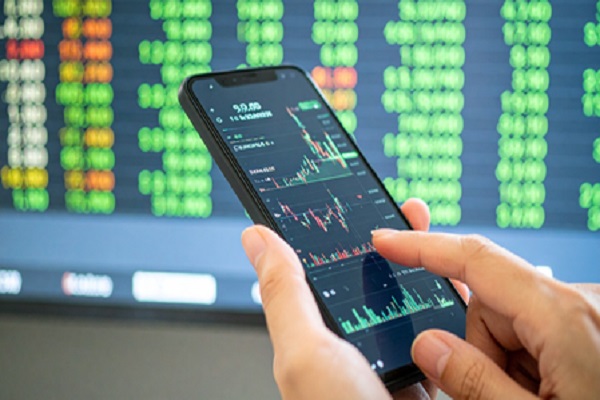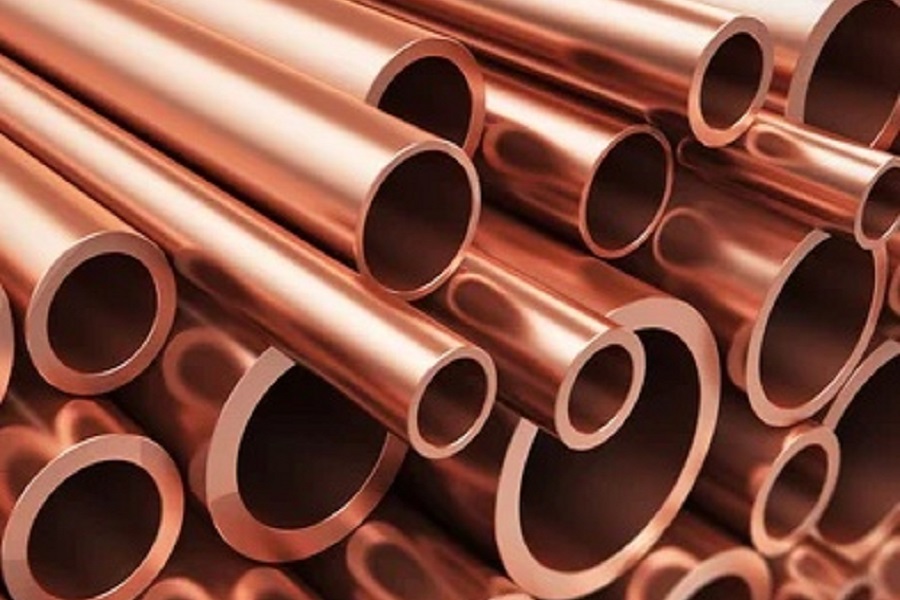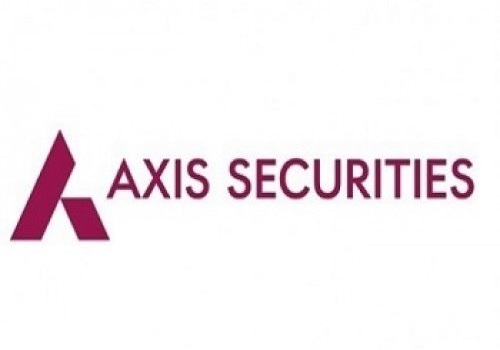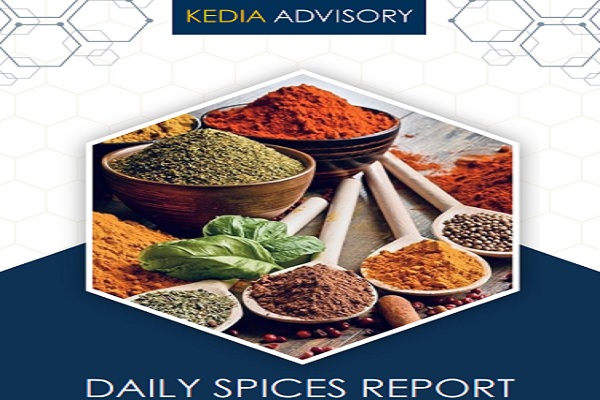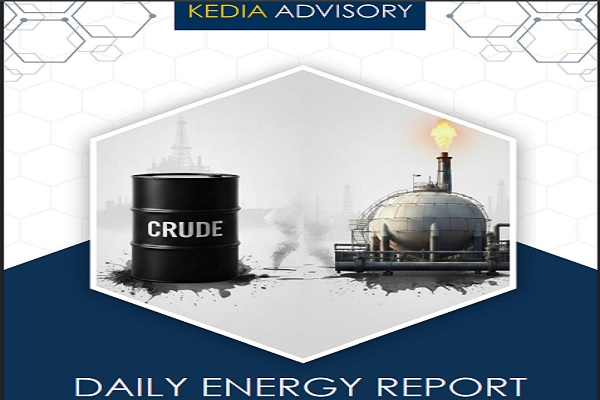Jeera trading range for the day is 19760-20280 - Kedia Advisory

Gold
Gold prices extended losses, settling 1.67% lower at 95,470, as easing geopolitical risks and improved global trade sentiment dampened the metal’s safe-haven appeal. The breakthrough US-China trade deal, finalizing the Geneva consensus, is a major factor behind the reduced risk premium. The agreement includes China approving export applications for controlled goods and the US lifting various trade restrictions, while the White House hinted at flexibility over tariff deadlines, further lowering uncertainty and pressuring bullion prices. On the monetary side, investors continue to gauge the Fed’s rate outlook amid expectations that President Trump could nominate a dovish Fed Chair by September or October, potentially favoring lower interest rates to support economic growth. In the physical market, India’s gold demand stayed muted even after prices corrected. Discounts narrowed to $18/oz, down from $27, as buyers held back for deeper corrections. Meanwhile, premiums in China rose to $12–$14/oz, up from last week’s $10, signaling resilient demand there. Globally, Q1 2025 gold demand rose 1% YoY to 1,206 metric tons, driven by a 170% surge in investment demand, although jewelry demand slumped 21% due to high prices. Central bank purchases also fell 21%, highlighting a mixed fundamental picture. Technically, gold remains under fresh selling, with open interest up 10.09% to 14,897 lots. Support lies at 94,780, with a break lower potentially testing 94,090. Resistance is at 96,330, and a move above could lift prices towards 97,190.
Trading Ideas:
* Gold trading range for the day is 94090-97190.
* Gold falls as fading geopolitical risks dent safe-haven buying appetite.
* White House hints tariff deadlines may be extended, further calming trade tensions.
* Trump may name new Fed Chair by September–October, likely backing dovish policy.
Silver
Silver prices fell sharply yesterday, settling 1.43% lower at 105,228, as a breakthrough U.S.-China trade agreement boosted global risk appetite, reducing safe-haven demand for precious metals. Markets welcomed the agreement to expedite rare earth shipments to the U.S., easing concerns over supply chain bottlenecks and trade tensions that previously supported bullion prices. Additionally, geopolitical risk eased further as the ceasefire between Iran and Israel largely held, further undermining silver’s defensive appeal. On the macro front, weaker-than-expected U.S. data reinforced bets for monetary easing later this year. U.S. consumer spending unexpectedly declined in May, while GDP for Q1 2025 was revised lower to a 0.5% contraction, highlighting the drag from tariffs. Traders now expect the Fed to cut rates by 75 basis points in 2025, potentially starting in September, which could lend longer-term support to silver but failed to offset immediate profit-taking. Despite softer prices, silver’s fundamentals remain constructive. The market is forecast to post its fifth consecutive deficit this year, with the shortfall seen narrowing by 21% to 117.6 million ounces, according to the Silver Institute. Industrial demand remains the key pillar, projected to rise by 3% to over 700 million ounces as green energy applications expand. Technically, silver is under long liquidation, with open interest plunging 105.46% to 3,186 contracts. Key support lies at 104,180, with a breach risking a further drop to 103,135. Resistance is now at 106,450, and a move above this level could push prices up toward 107,675 in the near term.
Trading Ideas:
* Silver trading range for the day is 103135-107675.
* Silver fell as U.S.-China trade deal lifted risk appetite, curbing safe-haven demand.
* Iran-Israel ceasefire continues to hold despite initial minor skirmishes.
* U.S. consumer spending unexpectedly fell in May as pre-tariff buying faded.
Crude oil
Crude oil prices edged lower by 0.43%, settling at 5,601, as traders weighed strong summer fuel demand against rising production and an upcoming OPEC+ output hike. The US summer driving season has kept demand robust, pushing crude inventories to an 11-year seasonal low, reinforcing near-term support for prices. The latest EIA data showed a much larger-than-expected drawdown in US crude stocks, down 5.836 million barrels, while gasoline and distillate inventories also fell significantly, signaling healthy refining activity and sustained end-user demand. Stocks at Cushing, Oklahoma, the key delivery hub, also dipped, adding to the bullish undertone for physical markets. However, supply-side pressures remain a counterweight. OPEC+ is widely expected to announce another production hike of 411,000 barrels per day at its upcoming July 6 meeting, while US shale producers continue to pump near record highs. Longer-term, the IEA expects global oil demand to keep expanding until 2029, peaking at 105.6 million bpd before easing slightly by 2030, supported by slower-than-expected electric vehicle adoption in the US and sustained gasoline affordability. However, rising global capacity—forecast to increase by 5 million bpd by 2030—suggests supply will be ample, leaving prices sensitive to geopolitical risks and OPEC+ policy cohesion. Technically, crude oil is under fresh selling, confirmed by a 4.27% rise in open interest to 14,054 contracts as prices softened by 24. Immediate support is seen at 5,548, with deeper downside risk to 5,495 if breached. Resistance is pegged at 5,656, and a breakout above could retest 5,711 in the near term.
Trading Ideas:
* Crudeoil trading range for the day is 5495-5711.
* Crude oil rose as US summer driving season boosted fuel demand and supported prices.
* Prices were also supported by multiple oil inventory reports that showed strong draws in middle distillates.
* Data from the U.S. EIA showed crude oil and fuel inventories fell a week earlier, with refining activity and demand rising.
Natural gas
Natural gas prices surged by 5.92%, closing at 318.7, supported by renewed optimism around LNG exports and strong weather-driven demand. The rally came as more U.S. liquefied natural gas (LNG) export plants resumed operations following seasonal spring maintenance, gradually boosting export flows that had dipped since April’s record high of 16.0 bcfd. Although average LNG flows in June remain lower at 14.2 bcfd, the gradual recovery indicates improving export capacity ahead of peak summer demand. On the production side, output in the Lower 48 states edged higher to 105.6 bcfd so far this month, slightly up from May but still shy of the March record due to earlier pipeline maintenance. Meanwhile, meteorologists expect hotter-than-normal temperatures to persist through mid-July, driving robust power demand for air conditioning. LSEG forecasts gas demand, including exports, will climb from 103.9 bcfd this week to 106.0 bcfd over the next two weeks, supporting bullish sentiment. Despite the demand optimism, storage levels continue to outpace seasonal norms. U.S. utilities added 96 bcf to gas storage for the week ending June 20, surpassing forecasts of 88 bcf and marking the tenth consecutive week of above-average injections. Total inventories now stand at 2.898 tcf, about 6% above the five-year average. Technically, the market is under short covering as open interest dropped by 19.87% to 17,157 while prices jumped by nearly 18. Immediate support lies at 309.2, with deeper support at 299.7. Resistance is pegged at 323.8, and a breakout above could push prices towards 328.9 in the near term.
Trading Ideas:
* Naturalgas trading range for the day is 299.7-328.9.
* Natural gas climbed as the amount of gas flowing to LNG export plants started to edge up
* US utilities added 96 billion cubic feet of gas to storage, marking the 10th consecutive week of above-average injections.
* Average gas output in the Lower 48 U.S. states rose to 105.6 billion cubic feet per day so far in June, up from 105.2 bcfd in May.
Copper
Copper prices slipped by 0.34% to close at 892.95 amid weak industrial data from China and some profit-taking by traders. Fresh figures showed that China’s industrial profits fell sharply again in May, highlighting slower factory activity and cooling sentiment in the world’s top copper consumer. This softer demand outlook pressured prices, although the downside remained contained due to persistent supply tightness and robust premiums in key markets. In the physical market, tightness is becoming more pronounced. Inventories in warehouses tracked by the Shanghai Futures Exchange (ShFE) plunged 19% week-on-week to 81,550 tons, marking a 70% slide over the past four months. Similarly, LME copper stocks have dropped 66% during the same period, driving up the premium for immediate delivery. The LME cash-to-three-month spread narrowed slightly to $250 per ton, down from Thursday’s multi-year high of $320, but remains historically elevated, reflecting acute near-term tightness. On the global balance, the International Copper Study Group (ICSG) reported a 50,000 metric ton deficit for April versus a surplus in March, reinforcing the supportive supply-demand picture despite weaker Chinese imports. Technically, the market is seeing long liquidation, with open interest dropping 4.18% to 7,648 lots as traders booked profits. Immediate support for copper is now at 888.4, with deeper support at 883.8. On the upside, resistance is pegged at 896.8, and a breakout above this level could push prices toward 900.6 in the sessions ahead.
Trading Ideas:
* Copper trading range for the day is 883.8-900.6.
* Copper fell on weak Chinese industrial profit data and profit-taking by traders.
* China’s industrial profits in May declined sharply year-on-year, pressuring sentiment.
* ShFE copper inventories dropped 19% weekly to 81,550 tons, down 70% in 4 months.
Zinc
Zinc prices ended marginally lower by 0.06% at 259.85, weighed by renewed demand concerns and a slight rise in available inventories. Stocks in Shanghai Futures Exchange (ShFE) warehouses rose 1.8% from the previous Friday, reflecting sluggish buying interest among Chinese consumers who continue to purchase zinc only to meet immediate needs amid weak manufacturing activity. Sentiment remains under pressure as China’s factory output growth hit a six-month low in May, keeping speculative interest muted while traders await concrete signals of industrial recovery and follow-through on global trade progress. Geopolitical calm, including the tentative ceasefire in the Middle East, also improved risk appetite, while stronger-than-expected Chinese retail sales provided hope for a boost to downstream metals demand. Meanwhile, supply-side factors remain supportive in the medium term. Zinc output in China fell 1% month-on-month in May and grew only slightly year-on-year, lagging expectations due to maintenance and unexpected disruptions across key smelting hubs. Global supply risks were also highlighted by Teck Resources reporting a 20% annual decline in production at its Red Dog Mine, and Australia’s Nyrstar cutting output by 25% for the year due to uncompetitive treatment charges. According to the ILZSG, the global zinc surplus narrowed to 16,000 tons in April from 23,400 tons in March, indicating a tightening balance. Technically, the market is under long liquidation as open interest slipped 1.87% to 3,717 lots. Immediate support is seen at 258.3, with deeper support at 256.6. Resistance is now likely near 261.1, and a break above could push prices to test 262.2 in the near term.
Trading Ideas:
* Zinc trading range for the day is 256.6-262.2.
* Zinc prices eased after SHFE zinc inventories rose 1.8% week-on-week, adding supply pressure.
* Weak manufacturing demand in China continues to weigh on zinc sentiment and spot buying.
* Chinese buyers are limiting purchases to immediate needs due to sluggish downstream demand.
Aluminium
Aluminium prices ended marginally lower by 0.12% to close at 247.85 as the market digested mixed supply-demand signals. China’s aluminium output rose robustly by 5% YoY to 3.83 million metric tons in May, pushing total production in the first five months of the year up by 4% to 18.59 million tons. However, the downside was capped by persistent concerns over raw material supply risks. Uncertainty around Guinea’s bauxite exports remains elevated due to the Guinean government’s dispute with Emirates Global Aluminium’s mining operations, threatening mining licenses from one of the world’s largest bauxite suppliers. The impact was visible as China’s bauxite imports from Guinea fell 21% month-on-month in May, forcing the world’s top aluminium producer to seek alternative supply channels to keep production steady. Meanwhile, global primary aluminium output in May rose by 1.5% year-on-year to 6.245 million tonnes, according to the International Aluminium Institute (IAI). In the physical market, premiums are trending lower amid weak demand. Japanese buyers agreed to pay a $108/ton premium for Q3 shipments, a sharp 41% drop from the previous quarter and the lowest since early 2024. Similarly, U.S. premiums dipped by over 7%, with traders speculating about potential tariff cuts on Canadian aluminium, which makes up about half of U.S. aluminium imports. Technically, the market is under fresh selling as open interest edged up by 0.36% to 4,146 lots, indicating mild new short positions. Aluminium now finds immediate support at 247, with deeper support at 246. On the upside, resistance is expected at 248.7, and a break above could lift prices to test 249.4 in the near term.
Trading Ideas:
* Aluminium trading range for the day is 246-249.4.
* Aluminium fell as China’s May production rose 5% y/y to 3.83 million tons, adding supply pressure.
* Downside was limited by persistent bauxite supply risks amid Guinea’s dispute with Emirates Global Aluminium.
* Global primary aluminium output rose 1.5% y/y in May to 6.245 million tons, IAI data showed.
Turmeric
Turmeric prices ended 0.67% higher at 14,094 yesterday, supported by short covering after recent profit booking dragged prices down on expectations of higher acreage due to favourable monsoon rains. Daily market arrivals rose modestly to 13,660 quintals from 11,940 quintals in the prior session, pointing to slightly improved availability. However, robust local buying interest at major mandis like Duggirala is helping to keep prices firm as traders continue to pay premiums for fresh, high-quality produce over older stocks. For the 2024–25 season, the area under turmeric cultivation is expected to expand by 15–20%, with about 3.30 lakh hectares estimated so far, up 10% from last year’s 3 lakh hectares. But despite this increase in acreage, actual output gains may remain capped due to adverse weather impacts such as untimely rains, which have affected rhizome quality in regions like Nanded. Trade remains active, with 50–55% of the new crop already traded and steady arrivals expected through the end of June. On the export front, turmeric shipments rose 6% YoY in April 2025 to 14,956.80 tonnes, though slightly down 0.92% month-on-month. Technically, the market is witnessing short covering, as seen in the 0.58% drop in open interest to 17,240 lots while prices edged higher by 94. Turmeric now finds support at 13,956, with deeper support at 13,816. Resistance is pegged at 14,300, and a decisive break could push prices to test 14,504 in the coming sessions.
Trading Ideas:
* Turmeric trading range for the day is 13816-14504.
* Turmeric gained on short covering after prices dropped due to expected increase in acreage.
* Turmeric acreage is expected to increase by 15-20% this season, supported by low competitive crop prices.
* In April 2025 around 14,956.80 tonnes were exported as against 14,109.10 tonnes in April 2024 showing a rise of 6%.
* In Nizamabad, a major spot market, the price ended at 14401.9 Rupees gained by 0.07 percent.
Jeera
Jeera prices closed 1.21% higher at 20,095 yesterday, driven by renewed export buying and easing geopolitical tensions in key producing countries like Syria, Turkey, and Afghanistan, which has temporarily tightened global supply lines. However, the upside for jeera remains capped due to the seasonal lull in retail demand and subdued overseas orders. Traders noted that foreign buyers have been largely inactive since the peak retail season ended, and the existing stocks in India are currently sufficient to meet any modest export requirements in the near term. Despite this week’s price gain, the underlying supply situation remains comfortable. Farmers are still holding nearly 20 lakh bags of cumin, with only 3–4 lakh bags likely to be sold by the season’s close, implying a healthy carry-forward stock of about 16 lakh bags. The latest trade figures reveal the export weakness clearly: jeera exports in April 2025 stood at 19,719.60 tonnes, a sharp 48% drop from April 2024, though they rose 13.74% over March 2025 levels, hinting at some short-term revival. Meanwhile, jeera imports also fell by 37.90% YoY, indicating limited inflows and a domestic market still well supplied from local production, which remains steady due to favourable weather and healthy sowing progress. Technically, jeera is witnessing short covering, evident from a 2.35% decline in open interest to 5,613 lots while prices gained 240. Immediate support lies at 19,930, with deeper support near 19,760. Resistance is now pegged at 20,190, and a decisive move above this level could push prices toward 20,280 in the sessions ahead.
Trading Ideas:
* Jeera trading range for the day is 19760-20280.
* Jeera prices continue to rise on strong export demand and easing geopolitical concerns
* However upside seen limited due to weak domestic and export demand post retail season.
* Total arrivals witnessed a marginal increase to 12,000 bags (55 kg each) as against 11,800 bags on the previous day.
* In Unjha, a major spot market, the price ended at 20245.6 Rupees gained by 0.21 percent.
Views express by all participants are for information & academic purpose only. Kindly read disclaimer before referring below views



